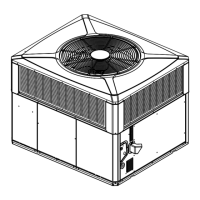18-BG07D1-1B-EN
25
Unit Startup
Pre-Start Quick Checklist
☐ Is the unit properly located and level with the
proper clearances? See “Determine Unit
Clearances,” p. 8.
☐ Is the duct work correctly sized, run, taped,
insulated, and weatherproofed with proper unit
arrangement as shown in the ductwork installation
section?
☐ Is the condensate line properly sized, run, trapped,
and pitched and shown in the Condensate Drain
Piping section?
☐ Is the gas piping correctly sized, run, trapped, and
purged of air? See Gas Piping Installation section.
☐ Is the filter of the correct size and quantity? Is it
clean and in place? See Air Filter Installation
section.
☐ Is the wiring properly sized and run according to the
unit wiring diagram?
☐ Are all the wiring connections, including those in
the unit tight?
☐ Has the unit been properly grounded and fused
with the recommended fuse size?
☐ Is the thermostat well located, level, and correctly
wired? See Electrical Wiring section.
☐ Have the air conditioning systems been checked at
the service ports for charge and leak tested if
necessary?
☐ Do the condenser fan and indoor blower turn free
without rubbing and are they tight on the shafts?
☐ Has the indoor blower speed been determined and
the proper speed been set? To adjust the fan, see
the Indoor Fan Motor Speed Tap Setting section.
☐ Has all work been done in accordance with
applicable local and national codes?
☐ Are all covers and access panels in place to prevent
air loss and safety hazards?
Starting the Unit in Cooling
Mode
NNoottee:: See the section on “Sequence of Operation” for
a description of the cooling operating sequence.
To start the unit in the cooling mode, set the
thermostat system switch to COOL and move the
thermostat COOL indicator to a setting below room
temperature. The condenser fan motor, compressor
and evaporator fan motor will operate automatically.
OOppeerraattiinngg PPrreessssuurree CChheecckkss
After the unit has operated in the cooling mode for a
short period of time, install pressure gauges on the
gauge ports of the discharge and suction line valves
(behind the Compressor access panel). Check the
suction and discharge pressures and compare them to
the normal operating pressures provided in the unit’s
SERVICE FACTS.
NNoottee:: Do not use the PRESSURE CURVES from the
unit's SERVICE FACTS to determine the unit
refrigerant charge. The correct charge is shown
on the unit nameplate. To charge the system
accurately, weigh in the charge according to the
unit nameplate and check subcooling against the
Subcooling Charging Table in the SERVICE
FACTS.
VVoollttaaggee CChheecckk
With the compressor operating, check the line voltage
at the unit (contactor is located behind the Control/Heat
access panel). The voltage should be within the range
shown on the unit nameplate. If low voltage is
encountered, check the size and length of the supply
line from the main disconnect to the unit. The line may
be undersized for the length of the run.
CCoooolliinngg SShhuutt DDoowwnn
At the thermostat, place the system selector to the OFF
position or reset the thermostat to a setting above
room temperature.
Starting the Unit in the Heat
Pump Heating Mode
NNoottee:: See the section on "Sequence of Operation" for a
description of the heat pump heating operating
sequence.
Check to make sure all grilles and registers are open
and all unit access doors are closed before start-up.
The thermostat may be temporarily operated in Manual
Test Mode for the *CONT402 or in Installer System Test
mode for the *CONT802 AND *CONT803. These are
modes designed to be used to "bump" the system on
the various capacity stages. Since the test mode
timeouts are 1 minute and 5 minutes respectively (in
the absence of installer key presses), these modes are
not designed to be used as the only means of system
checkout. Normal thermostat operation should be used
for operating the unit for extended periods of time.
To start the unit in the heat pump heating mode, set the
thermostat system mode to HEAT and adjust the
heating setpoint slightly above the room temperature.
Wait for the minimum compressor off time to elapse.
The condenser (outdoor) fan motor, compressor, and
evaporator (indoor) fan motor will operate
automatically.

